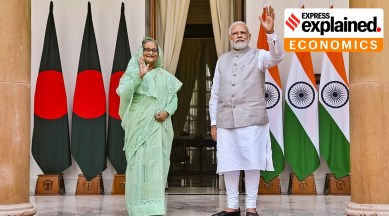Shubhajit Roy, Diplomatic Editor at The Indian Express, has been a journalist for more than 25 years now. Roy joined The Indian Express in October 2003 and has been reporting on foreign affairs for more than 17 years now. Based in Delhi, he has also led the National government and political bureau at The Indian Express in Delhi — a team of reporters who cover the national government and politics for the newspaper. He has got the Ramnath Goenka Journalism award for Excellence in Journalism ‘2016. He got this award for his coverage of the Holey Bakery attack in Dhaka and its aftermath. He also got the IIMCAA Award for the Journalist of the Year, 2022, (Jury’s special mention) for his coverage of the fall of Kabul in August 2021 — he was one of the few Indian journalists in Kabul and the only mainstream newspaper to have covered the Taliban’s capture of power in mid-August, 2021. ... Read More
India-Bangla trade, now set for CEPA boost
Prime Minister Narendra Modi has said India and Bangladesh will soon commence negotiations on a Bilateral Comprehensive Economic Partnership Agreement (CEPA). A look at the existing framework, and CEPA objectives

Following a meeting with the visiting Prime Minister of Bangladesh Sheikh Hasina, Prime Minister Narendra Modi on Tuesday said India and Bangladesh will soon commence negotiations on a Bilateral Comprehensive Economic Partnership Agreement (CEPA). “We both believe that by taking lessons from the Covid pandemic and recent global developments, we need to make our economies stronger,” Modi said.
“With the expansion of connectivity between our two countries, and the development of trade infrastructure on the border, the two economies will be able to connect more with each other, support each other. Our bilateral trade is growing rapidly. Today, India is the largest market in Asia for Bangladesh’s exports. To further accelerate this growth, we will soon start discussions on the Bilateral Comprehensive Economic Partnership Agreement,” he said.
Galloping trade
In 2021-22, Bangladesh has emerged as the largest trade partner for India in South Asia and the fourth largest destination for Indian exports worldwide. Exports to Bangladesh grew more than 66 per cent from $9.69 billion in FY 2020-21 to $16.15 billion in FY 2021-22.
India is Bangladesh’s second biggest trade partner, and its largest export market in Asia. Despite Covid-19 related disruptions, bilateral trade grew at an unprecedented rate of almost 44 per cent from $10.78 billion in 2020-21 to $18.13 billion in 2021-22.
India’s main exports to Bangladesh are raw cotton, non-retail pure cotton yarn, and electricity, and its main imports from the country are pure vegetable oils, non-knit men’s suits, and textile scraps.
CEPA objectives
While informal talks on CEPA have been happening since 2018, officials said that the pandemic has brought urgency. Chinese investments in Bangladesh were an initial trigger for India, but New Delhi and Dhaka want to step up the pace following the economic shock faced by the two economies.
The CEPA is likely to focus on trade in goods, services, and investment, with a key objective being the reduction of the trade gap between the two countries. As Bangladesh prepares to graduate into a developing nation by 2026 — after which it may no longer qualify for trade benefits that it currently enjoys as a least-developed country — it is keen to clinch the CEPA in a year.
The CEPA had figured prominently during the last commerce secretary-level meeting in New Delhi in March this year.
Existing frameworks
The current institutional frameworks for trade and investment include:
* During the visit of Prime Minister Modi to Bangladesh in June 2015, the bilateral trade agreement between the two countries was renewed for a period of five years with a provision for auto renewal.
* Under the provisions of the South Asian Free Trade Area (SAFTA), Bangladesh extends preferential tariffs to Indian exports of products outside the ‘sensitive list’ of 993 items. In 2011, India announced duty-free, quota-free access to Bangladesh for all tariff lines except tobacco and alcohol.
* An Agreement on Promotion and Protection of Investments has been in force since 2011. Joint Interpretative Notes to the agreement were signed during the visit of the Indian Finance Minister to Bangladesh in October 2017.
* To facilitate trade and transit through inland waterways, a Protocol on Inland Waterways Trade and Transit (PIWTT) has been in place since 1972. The PIWTT too was renewed for a period of five years with a provision for auto renewal during Modi’s visit to Bangladesh in 2015. The protocol allows the movement of goods by barges/ vessels on eight routes between points in India and Bangladesh, as well as between points in India through Bangladesh.
* Direct sea movement of containerized/ bulk/ dry cargo began after the signing of a Memorandum of Understanding (MoU) on Coastal Shipping in June 2015. This has reduced the shipping time between India and Bangladesh from 30-40 days to 7-10 days, and has the potential to emerge as an economical mode of transportation for business communities on both sides.
* MoUs were signed in 2015 on the use of the Chittagong and Mongla Ports for Movement of Goods to and from India.
* The MoU on Border Haats on the India-Bangladesh border was renewed in April 2017 during the visit of Prime Minister Hasina to India. Currently, four Border Haats — two each in Meghalaya (Kalaichar and Balat) and Tripura (Srinagar and Kamalasagar) — are functional. Work on setting up two more haats on the Tripura-Bangladesh border and four on the Meghalaya-Bangladesh border is under way. The two sides have also decided to identify locations for another six Border Haats.